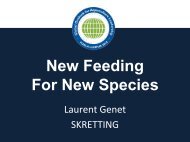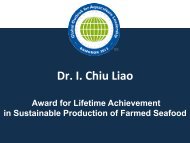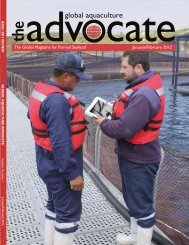May/June 2010 - Global Aquaculture Alliance
May/June 2010 - Global Aquaculture Alliance
May/June 2010 - Global Aquaculture Alliance
You also want an ePaper? Increase the reach of your titles
YUMPU automatically turns print PDFs into web optimized ePapers that Google loves.
marketplace<br />
Farmed Or Wild?<br />
Both Types Of Salmon Taste Good And Are Good For You<br />
Farm-raised Atlantic salmon are raised and harvested under<br />
controlled conditions that provide a year-round supply of fish.<br />
Photo courtesy of the British Columbia Salmon Farmers<br />
Association.<br />
Summary:<br />
Whether farmed or wild, salmon are tasty fish and a<br />
healthy protein choice. They look and taste nearly the<br />
same. Wild Pacific salmon are harvested by fishing,<br />
mostly in the north Pacific from <strong>June</strong> through September.<br />
Frozen or canned wild salmon are available outside<br />
this period. Farmed Atlantic salmon are hatched,<br />
raised and harvested under controlled conditions, and<br />
available fresh year-round, usually at lower prices than<br />
wild-caught fish.<br />
Salmon is the second most-popular fish consumed in the<br />
United States. It tastes savory and earthy, yet slightly sweet, and<br />
is among the richest sources of long-chain omega-3 fats. It is<br />
also full of high-quality protein, vitamins and minerals.<br />
Research shows that eating fish like salmon promotes healthy<br />
hearts and brain development. All types of commercial salmon<br />
are healthful to eat. The most readily available kinds in the U.S.<br />
are wild Pacific and farmed Atlantic salmon. Farmed and wild<br />
salmon are very similar in many ways.<br />
Salmon FAQs<br />
How do farmed and wild salmon differ?<br />
Farmed and wild salmon are usually different species of fish.<br />
Most farmed salmon are Atlantic salmon, Salmo salar. Wild<br />
populations of Atlantic salmon are generally at very low levels,<br />
Pamela D. Tom<br />
University of California – Davis<br />
Sea Grant Extension Program<br />
Food Science and Technology Department<br />
1 Shields Avenue<br />
Davis, California 95616 USA<br />
pdtom@ucdavis.edu<br />
Paul G. Olin<br />
University of California<br />
Cooperative Extension<br />
Sea Grant Extension Program<br />
Santa Rosa, California, USA 95403<br />
and their commercial harvest is limited. Farm-raised fish are<br />
hatched, raised and harvested under controlled conditions comparable<br />
to other farmed animals. Farmed Atlantic salmon are<br />
available year-round in fresh or frozen forms.<br />
Most wild-caught salmon are one of five species of Pacific<br />
salmon. They are harvested by fishing with a variety of gear<br />
types, mostly in the north Pacific from <strong>June</strong> through September.<br />
Fresh wild Pacific salmon are available during this time. The rest<br />
of the year, frozen or canned wild salmon are available.<br />
How are farmed and wild salmon similar?<br />
Farmed and wild salmon have very similar nutrients. Atlantic<br />
salmon and Pacific salmon look similar on the outside. But<br />
between species and even within the same species, each type of<br />
salmon can have different flavors, textures and flesh color. How<br />
the fish is processed and handled can also dramatically influence<br />
these characteristics.<br />
In taste tests between farmed and wild salmon, sometimes<br />
farmed salmon is preferred. Sometimes taste panels prefer wild<br />
fish. However, these taste tests often compare farmed and wild<br />
salmon of different species and are not really designed to tell the<br />
differences between the tastes of the farmed and wild versions of<br />
the same type of salmon.<br />
Often, wild salmon is priced higher than farmed salmon.<br />
Especially when buying fish fillets, it can be hard to tell the difference<br />
between how farmed and wild salmon look. It may take<br />
DNA analysis to confirm the identity of the species. Species substitutions<br />
sometimes occur, either accidentally or through business<br />
practices that mislead consumers. Consumers should buy salmon<br />
from trustworthy retailers and restaurants with good reputations.<br />
What do salmon eat?<br />
For survival and growth, both farmed and wild salmon need<br />
a well-balanced diet of protein, carbohydrates, fats, vitamins,<br />
minerals and pigments. In the wild, salmon eat zooplankton and<br />
fish. About 4.50 kg of prey is needed to make 0.45 kg of wild<br />
salmon. This means wild salmon have a feed-conversion ratio<br />
(FCR) around 10:1.<br />
Farmed salmon need the same well-balanced diet to live and<br />
grow. They are fed a combination of fishmeal, fish oil and other<br />
Table 1. USDA nutrition information for 100 g of farmed and wild salmon cooked under dry heat.<br />
Calories Protein (g) Fat (g) Saturated Fat (g) Sodium (mg) Cholesterol (mg) Omega 3 (g)*<br />
land-based protein sources. The FCR is around 1:1. However, it<br />
should be noted that the water content in live prey items is much<br />
higher than in feed.<br />
Some nutrients in prey and feed are considered essential<br />
because fish are unable to make them, so they must come from<br />
the diet. One such nutrient is the orange pigment astaxanthin,<br />
which is in the same family of nutrients as vitamin A. It is a powerful<br />
antioxidant that is thought to be involved in the ovarian<br />
development, hatching, survival, growth and respiration of<br />
salmon. Astaxanthin is also what causes the reddish-orange color<br />
of salmon flesh.<br />
The color of wild and farmed salmon can vary widely from red<br />
to orange-red, rose, pink and even white. The color depends<br />
mostly on the amount of astaxanthin in the diet. Wild salmon get<br />
natural astaxanthin from the prey they eat. Farmed salmon get<br />
natural or added astaxanthin from the feed they eat.<br />
How does eating farmed and wild salmon make people healthier?<br />
Both farmed and wild salmon are healthful choices that are low<br />
in total fat and high in protein (Table 1). Both are rich in vitamins,<br />
minerals and omega-3s. In recent years, research has linked eating<br />
seafood to many health benefits throughout life.<br />
Babies of moms who eat fish during pregnancy have the best<br />
possible brain and eye development. Adults who eat fish twice a<br />
week have up to 40% lower risk of dying from a heart attack. And<br />
a seafood-rich diet can help prevent depression and dementia as<br />
people age.<br />
Is salmon safe to eat?<br />
Most foods contain traces of substances other than nutrients.<br />
Scientists have compared concerns with eating fish to concerns<br />
with limiting or avoiding fish. They found that the biggest risk is<br />
limiting or avoiding fish, which results in thousands of extra heart<br />
disease deaths per year and less than optimal brain development<br />
in children.<br />
The essential nutrient astaxanthin, which causes the red-orange<br />
coloration of salmon, is also involved in growth and reproduction.<br />
Wild fish get astaxanthin from their prey, while farmed<br />
fish receive it in their feed. Photo courtesy of Camanchaca, Inc.<br />
62 <strong>May</strong>/<strong>June</strong> <strong>2010</strong> global aquaculture advocate global aquaculture advocate <strong>May</strong>/<strong>June</strong> <strong>2010</strong> 63<br />
Farmed<br />
Atlantic<br />
Coho<br />
wild<br />
Chinook<br />
Sockeye<br />
Coho<br />
Pink<br />
Chum<br />
206<br />
178<br />
231<br />
216<br />
139<br />
149<br />
154<br />
22.1<br />
24.3<br />
25.7<br />
27.3<br />
23.4<br />
25.5<br />
25.8<br />
12.3<br />
8.2<br />
13.3<br />
10.9<br />
4.3<br />
4.4<br />
4.8<br />
2.5<br />
1.9<br />
3.2<br />
1.9<br />
1.0<br />
0.7<br />
1.0<br />
* Omega-3 values equal the sum of eicosapentaenoic acid and docosahexaenoic acid.<br />
61<br />
52<br />
60<br />
66<br />
58<br />
86<br />
64<br />
63<br />
63<br />
85<br />
87<br />
55<br />
67<br />
95<br />
2.1<br />
1.2<br />
1.7<br />
1.2<br />
1.0<br />
1.3<br />
0.8





